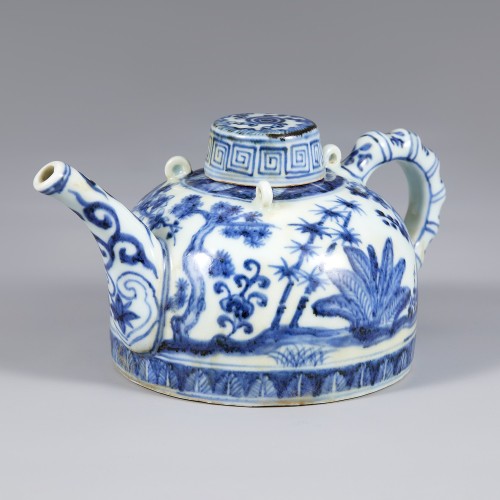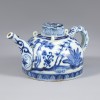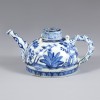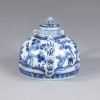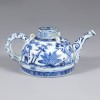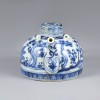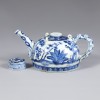본문
명나라 선덕 연간(1426~1435)에 제작된 유물입니다. 뚜껑이 있는 반구형의 소형 주자로 의례에 사용되었으리라 추정됩니다. 세 개의 작은 고리가 달려있고 손잡이는 대나무 마디 형상이어서 삼계 죽절호(三繫 竹節壺)라고 부릅니다. 표면은 짙푸른 청화로 문양을 표현하였습니다. 뚜껑에는 뇌문(雷紋)이, 주구에는 여의두문(如意頭紋)과 당초문(唐草紋)이, 손잡이에는 대나무 마디가 그려졌습니다.
몸체에는 송죽매문(松竹梅紋)이 시문되었는데 소나무, 대나무, 매화는 흔히 ‘세한삼우(歲寒三友)’라고 불리는 소재입니다. 이 세 가지 소재는 추운 겨울에도 시들지 않는 강인함과 절개를 의미하며 군자의 덕성을 상징합니다. 이처럼 삼계 죽절호라는 기형과 송죽매 문양이 조화로운 유물은 흔치 않아 귀중하며 황실이나 귀족이 사용한 것으로 추정됩니다.
器物于明代宣德年间(1426—1435年)制作。此器为带盖的半球形小壶,推测曾用于礼仪场合。壶身设有三个小系,壶柄作竹节状,因而得名“三系竹节壶”。外壁以青花描绘纹饰,壶盖饰雷纹,流部绘有如意头纹与唐草纹,柄部绘竹节纹。
壶身通体绘松竹梅纹,即常称的“岁寒三友”。松、竹、梅这三种植物在严冬不凋,象征坚韧与高洁,寓意君子之德。三系竹节的造型与岁寒三友的纹饰相得益彰,极为罕见,推测为皇室或贵族使用的珍贵器物。
This artifact was produced during the Xuande reign of the Ming dynasty (1426–1435). It is a small, hemispherical ewer with a lid, presumed to have been used for ceremonial purposes. Three small rings are attached, and the handle is shaped like bamboo joints, hence the name “Three-Ring Bamboo-Joint Ewer”. The surface is decorated with deep cobalt-blue underglaze designs. The lid features a thunder pattern, the spout bears ruyi-head and arabesque motifs, and the handle is painted with bamboo nodes.
The body is adorned with a design of pine, bamboo, and plum, a combination often referred to as the “Three Friends of Winter”. These three items, which do not wither even in the cold of winter, symbolize resilience and integrity, representing the virtues of a noble gentleman. Artifacts that harmoniously combine the rare form of the Three-Ring Bamboo-Joint ewer with the pine, bamboo, and plum motif are highly prized, and this piece is believed to have been used by the imperial court or nobility.
